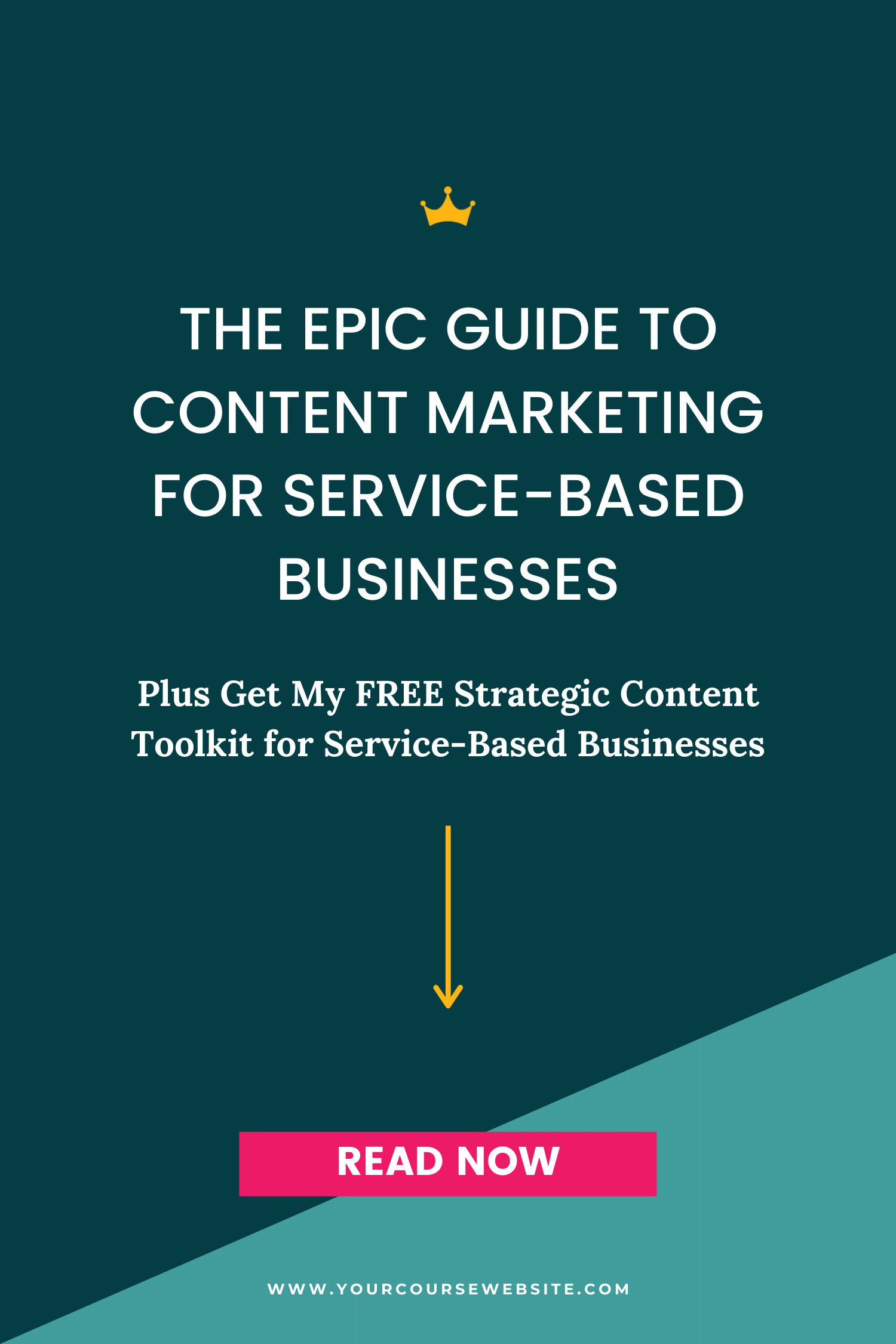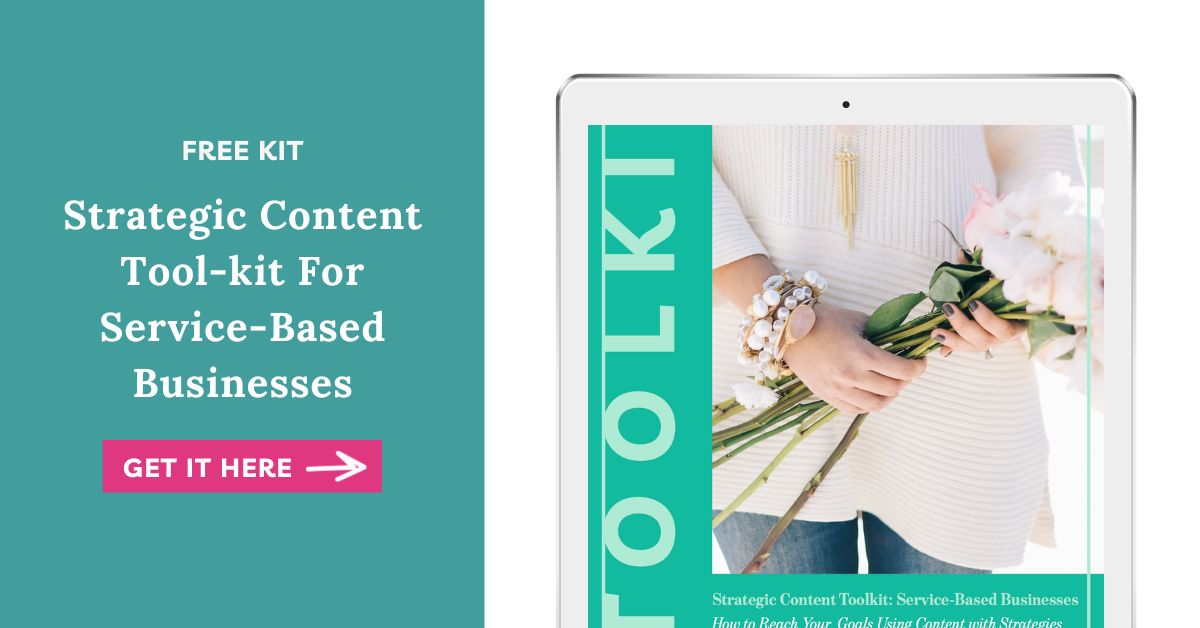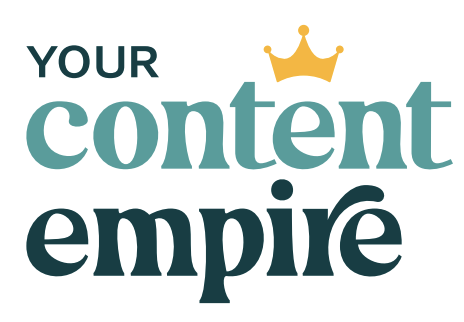Did you know that the strategies for content marketing for service businesses differ from those used for marketing a product-based business? Recently I published a similar post (“The Epic Guide to Content Marketing for Product-Based Businesses”) and thought that my fellow service-based entrepreneurs deserved their own in-depth guide to using content to effectively achieve their business goals.
I’m a firm believer that the way to build your business, attract more valuable leads, convert those leads into clients and friends is by using content marketing. Especially if you don’t have a huge team or unlimited dollars to spend on paid marketing.
So I’ve pulled together my best tips for creating a content marketing strategy specifically for service-based businesses. If you would rather just jump right in, Download the Strategic Content Toolkit for Service-Based Businesses to get started.
Prefer to watch this blog post instead? Click on the video below!
Your Content Marketing Goals
Your content goals will definitely vary from business to business and should be determined by what your overall business goals are, but these are the 3 main categories of content goals that apply almost universally to service-based businesses.
Establishing Yourself as an Expert Who Gets to Understand What They’re Going Through
One aim of your content is to establish yourself as an expert who completely understands what your ideal customers are dealing with and struggling with, and as a result, how you can help them.
This is super important because as a service-based business, your customers aren’t just looking at a purchase decision, they’re looking at a relationship decision – who do they want to work with? Who is the most empathetic to their situation? And who by extension is the most qualified to help solve their problem?
Most of these decisions are made based on trust and instinct.
One way to establish yourself as an expert who also deeply understands their current situation and their future vision? Create content that solves a problem for them. Create content that treats them as an individual. Create content that deepens your relationship with your readers. And only pitch your offer once you’ve established that relationship and have helped them solve a problem.
Takeaway Action: Talk to a lot of potential customers to get an understanding of what types of problems you can solve and solutions you can offer.
Building Your Email List So You Can Keep in Touch with Prospects
Like any online business, one of your most valuable assets is your list of vetted leads for your services (aka your email list). It’s the most reliable means of staying in touch once they’ve left your website. Social media algorithms change all the time and you don’t actually OWN your Instagram profile, or your Pinterest account, theoretically it could disappear at any point. But with an email list, you own it and can take that relationship with your prospects into your own hands and nurture it.
Building A Sales Funnel That Aligns With Your Sales Process To Increase The Number Of Sales Conversations You’re Having
So we’ve already covered why you want to grow your email list, but similarly, you want to have a purpose for people who join your list. If somebody came to your house to see you, you probably wouldn’t just invite them in and then not talk to them the entire time they’re there. It’s the same thing with your email list. It’s up to you to nurture that relationship and, depending on your sales process, nudge them in the direction of booking a sales conversation.
Your subscribers signed up to your list for a reason – to get your help with a problem. If you can help them even more through your paid services, that’s exactly what you should invite them to do. Because of this, you want to make sure that every piece of your funnel relates to your paid service and supports your sales process – from the freebie, to the email sequence, to how you promote your freebie.
Your Content Marketing for Service Businesses Strategic Toolkit – Before Your Begin
Here are my main, tried-and-true strategic tools for the service-based business to have in place before you even think about creating your content strategy.
Ideal Client Avatar
Go ahead and roll your eyes if you’ve heard this one before. But there’s a reason it’s pretty much become a cliché. If you water down your message, trying to make it appeal to the most people, you’ll end up attracting no one.
Now if you take the opposite approach (which may seem a little bit counterintuitive right now), and hone in on 1 client type, your ability to articulate exactly what they’re struggling with and want most from a solution will prove that your service is the one for them. Your message will gain the clarity and focus needed to make a significant impact.
And as an added bonus to this approach, when you sit down and pretend you’re writing to one person that you know really well, the pressure of nailing the perfect email/blog post/social message will be off and the words will just flow.
Content Mapping Your Client's Journey
The best part about having a content strategy is that it takes you from being reactive with your content and throwing out random posts on a whim to being intentional with content. This helps you to mindfully take your readers on a journey from completely-new-to-you to a reader to a first-time-client to a brand advocate.
Takeaway Action: Read this post on how you can Create a Better Content with a Reader Journey Map and use it when you’re coming up with new content topics, writing posts, creating sales copy and coming up with new offers (or updating old ones).
Unique Selling Proposition
What makes your business different from other experts selling similar services? Your unique selling proposition. Having a clear idea about what makes you stand out from the crowd will help you articulate it throughout your content AND will help you overcome any competition (competition doesn’t exist if you focus on what makes you unique!)
Assessing Your Playing Field (SWOT)
This is actually a great exercise to do every 3 months or so because it helps you identify the opportunities and potential potholes that are on your current playfield. By doing this when I was just starting my business in 2014, I was able to identify a partnership that ended up providing more than half of my income for my first year of business.
Takeaway Action: Complete a SWOT table of what’s currently happening in your business. Once we have that information, you’ll be able to make some strategic decisions about your content! Download the toolkit here if you’d like.
The 1:1 Magic Content Ratio
This strategic tool basically just refers to the ratio for you to keep in mind with any content you produce – a rule of thumb that will help your content reach the targets you’re hoping for: For every piece of content you produce, spend at least as much time promoting it.
Without promotion, your content is basically a deserted island. If you want people to visit it, you’re going to have to provide some boats.
Takeaway Action: Do you have blog posts that you know you haven’t promoted enough? Put them back on the forefront and schedule a week to promote them to the fullest. Not only will they get more eyeballs, but you’ll also get a break from having to create something new!
Your Content Brand
The next step in creating your service-based business content strategy is to develop your content brand. If you already have a strong brand and style guide for your business, this will be easy. If not, you’ll probably want to go back and start there, carry it through to your website, social media, and other brand touchpoints before starting on this step.
Content is an outlet for your brand. An incredibly important one, but it still flows from your brand, not separately.
Here are the two main things to consider when developing your content brand:
How Your Content Fits into Your Visual Brand
Your content plays a big role in building brand recognition for you as an expert and service provider. But in order to successfully do this, you have to carry through your brand’s stylistic elements throughout your branded content images on a consistent basis.
You want to have a blog-style defined with the following types of guidelines specified: header formatting, text formatting, font colours, blog image templates, social media image templates, etc.
Finding Your Voice and Style
The visuals are just one tiny piece of your brand. Another piece is your brand voice and personality. This is one of the biggest differences between a service and product business.
With a product business – you get to develop the brand voice that resonates most with your target customers.
Whereas with a service business, your brand voice has to be much more of a personal brand because people are signing up to work with you and/or your contractors/employees. The major deciding factor of whether to hire you over someone else comes down to whether they (a) trust you; and (b) like you.
Answer these questions to start defining your brand voice:
Relationship
- What type of relationship do you want with your clients?
- What type of relationship do your clients want from the service-provider they hire for [insert your service here]?
- How is your relationship with your client-defined?
Speaking their language
- How would your clients describe the problem your service solves? (if not a direct problem – think sideways to uncover the void your service fills for them)
- How would your clients describe the benefits of your service? The benefits they personally receive, benefits over your competitors, and any additional perks.
- Find the description – In your client’s words, how would you describe your service?
- Bonus points – use surveys, forums and interviews to fill these descriptions and language guides with your client’s actual words.
Use these answers to guide your content creation and language throughout any of your business’ brand touchpoints (website, social media, blog, newsletter, freebies, service/package descriptions, sales materials, email templates, customer service, etc.)
Your Content Categories
For a service-based business, the purpose of your content falls into a least one of the previously-mentioned Content Goals:
- Establishing yourself as an expert who gets to understand what they’re going through
- Building your email list so you can keep in touch
- Building a sales funnel that aligns with your sales process to increase the number of sales conversations you’re having
How-Tos and Tutorials
A great style of blog posts for service-based businesses is the how-to post. It immediately puts you into the role of expert where you get to easily deliver value to your readers.
Another benefit? They’re really easy to write. One common fear I hear about this type of content is that service-based business owners are afraid of giving away all of their ‘trade secrets.’ But that’s not the case (and in the rare chance it is – that person is likely a DIY’er and wasn’t going to hire anyone in the first place).
Use your content to give teasers, or how to complete small segments of stuff related to your area of expertise. It’s unlikely that you’re going to create a post with the full a-z, here’s everything I can do for you if you hire me and how to do it yourself.
For example, a wedding planner might offer content on a very small piece of wedding planning to her audience of potential customers – how to determine your wedding budget, how to find a wedding planner that gets your vision, and how to choose a venue.
Interviews and Case Studies
One of the best ways to market through your content? Let your results speak for themselves. That’s where this content category shines for service-based businesses. Let your clients and the results that you’ve helped them achieve take centre stage through interviews and case studies.
Interpreting Trends
Another post category that service-based businesses can leverage is trends in the industry – explaining what it is, dispelling myths, talking about how to use it. What’s great about these posts is that they have major SEO benefits, they’ll establish you as an expert who has a finger on the pulse of all the latest and greatest and researching/writing your posts will play double duty in you learning about the trends and new techniques as well.
Here’s an example – if you are a web designer, you might do a post on the latest WordPress updates, or new plugins or new Google developments that affect websites.
Behind-the-Scenes and “Living Your Talk” Type Posts
One of my favourite types of content are behind-the-scenes posts. The ones that give your audience a sneak peek of how you provide a service for your own business. This type of content builds major credibility while taking the pressure off you to be the expert with all the answers.
Takeaway Action: Come up with your content categories and use this to brainstorm ideas. You’ll find the worksheet in the toolkit (click on the image above!).
Your Newsletter Strategy
One of the main purposes of your content strategy as a service-based business is to build your email list. But just using it for sales emails and only sending something when you have something to sell? Lame.
Especially as a service-based business, your newsletter is one of the best tools you have to build a relationship with your audience (potential clients), keep your services and business top-of-mind and to get them used to seeing you show up in their inbox regularly with fun and useful stuff to show them.
This section will give you some specifics on creating your newsletter strategy.
Sign-Up Gifts (or how do you get them to sign up in the first place)
Since you want your email list to be filled full of prospects interested in your services, you want to start with the end in mind. What service or package do you want to sell with your main email list? Work backwards from that offer to find out what that prospect would be interested in.
So – if they’re serious about getting help with your service area, what freebie would interest them as well? Here are some options that might be perfect for your newsletter strategy:
- Digital Kit: Create a collection of resources to help your prospect solve a problem related to your service area. Things to include in your kit might be: cheat sheets, worksheets, templates, resource lists, walk-through tutorials, etc.
- Email Course: Similar to the idea above in that you’ll be trying to help your prospect solve a problem related to your main service or package, put together a step-by-step, mini course that’ll walk them through doing something or teach them something they want to learn
- Webinar or Workshop: Either live or recorded, put together a webinar or workshop where you teach them something, they can ask questions (giving you the opportunity to showcase your brilliance) and they can see you live in action!
- Challenge: Similar to the “niche-out to niche-in” strategy, but is there a daily challenge you could run that relates to your general business category (i.e. 30-day smoothie challenge or 10-day decluttering challenge)
- Quiz that helps with a decision: Can you put together a quiz to help your prospect learn something about themselves AND point them towards the particular package or service that’s perfect for them! Talk about tailored-to-them marketing!
What to Send in Your Regular Newsletter
So now that you have your newsletter set up and a sign-up gift in place to entice potential clients to join your list in the first place, it’s time to come up with a plan of what you’ll send.
Step 1. Choose your frequency
You should be sending something to your email list at least once a month (ideally once a week). Otherwise, your subscribers won’t remember why they signed up in the first place.
Step 2. Decide what you’ll send
Choose 1-2 types of emails you’ll send to your list (aside from promotional emails) Here are some ideas:
- Your Blog Posts: Send a weekly email with a link to your latest blog post. Take advantage of your footer to showcase one of your packages/services.
- Behind-the-scenes: Send a behind-the-scenes email of your blog post or aspect of something you’re working on that week (sneak peek).
- Exclusive free gifts: Whenever you create a new freebie or content upgrade – send it to your list so they can participate too!
Takeaway Action: Decide on your email newsletter plan – what free gift you’ll use and what you’ll be sending in your regular emails. Download the Workbook Here.
Your 3 Biggest Content Marketing for Service Businesses Power Moves
As a service-based business, here are your 3 biggest content marketing power moves:
Guesting
Guesting, encompassing everything from guest posting, to being a guest expert, to doing podcasts, any place where you’re sharing your knowledge and expertise with someone else’s audience, is one of the best (and quickest) ways for service providers to grow their own audiences.
The right guest spot could mean breaking into a whole new market full of potential clients who weren’t aware of you before. Use this to your advantage, look for influential people who your potential customers follow and trust. This sort of outreach should have a central role in your content strategy.
Welcome Email Sequence
The second most powerful content marketing tool for content marketers is to set up a welcome email sequence that guides readers from new subscribers to the point of sale for your paid offer.
There are two keys to doing this successfully: (1) having an opt-in freebie that directly relates to your paid offer so that their email journey progresses naturally; and, (2) identifying the point of sale that most of your sales come through (is it through discovery calls? Directly on your website? Sales emails? Somewhere else?) and using that call to action throughout the sequence.
For example, if most of your service packages are sold through a discovery call, inviting them to book a free call becomes your call-to-action throughout the entire sequence. Having a single goal and a single call-to-action will be more effective for you than scattering a bunch of call-to-actions and having multiple goals for your emails/content.
Your Own Voice and Personality
As a service-based business owner, it’s your personality that’s going to cinch the deal and help you stand out from businesses offering similar services. So tap into what makes you, you and your content will attract your dream clients while repelling those who you don’t want to work with.
Tying it All Together – Content Marketing for Service Businesses
There are many steps involved in a content marketing strategy, like defining your goals, refining your content brand, deciding on your content categories, and implementing a newsletter strategy.
Even though there’s a lot of work behind the scenes that goes into your content marketing, with the right plan in place it’s all doable. You don’t need to spend a lot to be successful in marketing your service-based business. If you can pour some energy into your content marketing plan, you can achieve your business goals.
Download the Strategic Content Toolkit: Service-Based Businesses to get started on creating your service-based content marketing strategy.












